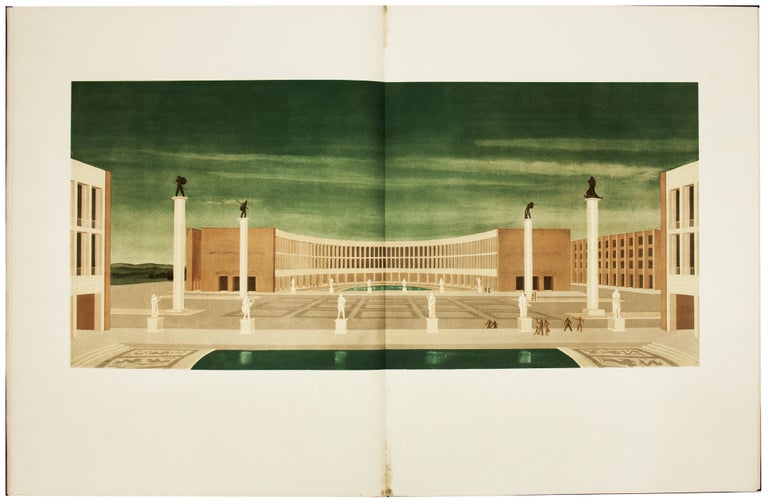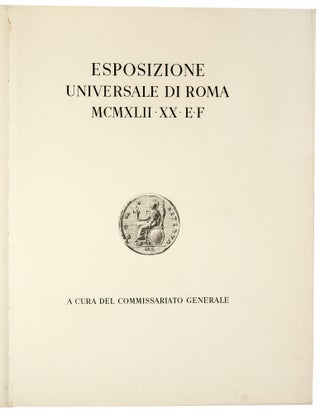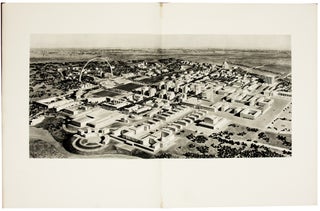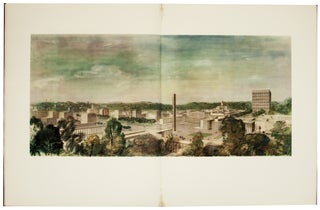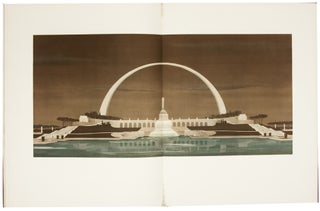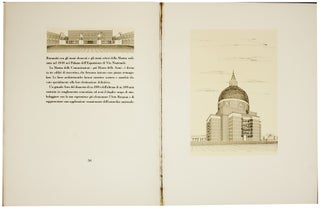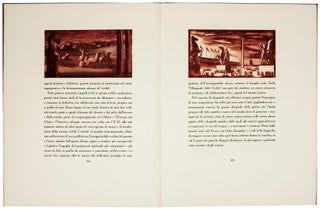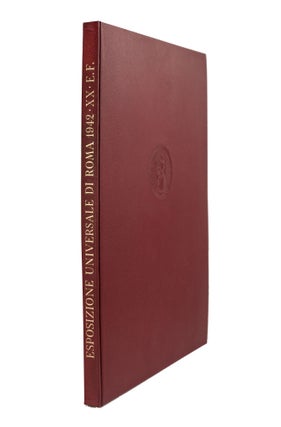Esposizione Universale di Roma MCMXLII .XX. E. F.
Folio [59.0 x 44.5 cm], (1) f., (3-16) pp., 17-87 pp., (1) p., (1) f. colophon, with (29) illustrations in the text (4 of which are double page, 13 of which are full page, the majority in color, and 2 of which are photos of Mussolini and of Victor Emmanuel III of Italy). Bound in original publisher’s red leather, title gold tooled on spine, blind-stamped image of ancient roman coin on upper cover, blind-stamped image of fasces on lower cove. Without its original publisher’s box. Very minor rubbing to binding. Occasional minor marginal internal staining on pastedowns, flyleaves and around the gutter, not affecting the illustrations and text block. Generally excellent. Rare first edition of this deluxe, illustrated atlas folio published in 1939 as an advance prospectus showcasing the architecture of the Esposizione Universale di Roma, the world’s fair planned for 1942 to celebrate twenty years of Fascism under Benito Mussolini. Because of the outbreak of World War II the fair was never held, but much of its built environment was later completed and today forms the core of the EUR district of Rome, an important example of mid-century urban planning famed for its Fascist-era architecture. The volume’s 29 illustrations (4 of which are double page and 13 of which are full page) were printed by the Milan firm Arti Grafiche Pizzi & Pizo, which specialized in fine commercial color-offset work. Published before any of the buildings were complete, and before many were even begun, the book is thus a valuable witness to the genesis of this ambitious project, and its vibrant illustrations are in their own right intriguing examples of Fascist-era aesthetics. The project, initially known as E42 (Esposizione 1942), was first conceived in 1936 under the direction of Vittorio Cini, who wrote the preface to this volume. The idea was to construct an entirely new district to direct the expansion of Rome southwest, toward the sea. This district would be both a showpiece for the fair and become a new city center. Following some controversy about architectural and urban-planning principles, the project was shared by Marcello Piacentini (1881-1960) and Giuseppe Pagano (1896-1945), leaders of the rival factions of reactionaries and progressives in Italian architecture, who assigned their own preferred architects to design individual buildings in the district. The overall design was inspired by Roman Imperial town planning, with modern elements from Italian rationalism, the result being a spare form of neoclassicism, with wide axially planned streets and austere buildings in limestone, tufa and marble. The Esposizione Universale di Roma was cancelled on 3 June 1941, but after World War II it was decided that EUR could be the basis of an out-of-town business district, an idea that other European capitals did not take up until decades later (e.g., London’s Docklands and La Défense in Paris). In the 1950s and 1960s the unfinished Fascist-era buildings were completed and other new buildings were added in contemporary styles, all for use as corporate offices and government buildings. EUR thus offers a glimpse of how Italian cities might have come to look had the Fascist regime not fallen. The volume illustrates the most notable structures to be seen today in EUR, including the Palazzo dei Congressi, the Palazzo dell’INPS, the church of Santi Pietro e Paolo a Via Ostiense, and the iconic Palazzo della Civiltà Italiana, sometimes called the Colosseo Quadrato (‘Square Colosseum’). Also illustrated are numerous features which were never built, the most prominent of which was a 100-meter-high monumental arch which later would provide inspiration for Eero Saarinen’s (1910-61) ‘Gateway Arch’ in St. Louis (designed in 1947). While the volume is principally devoted to the built environment of the exposition, space is also given to new transportation systems for the fair/district, matters of lodging, entertainment, media, and to the recent excavations at Rome’s ancient port of Ostia. This deluxe folio volume, which the colophon states was published in 1200 copies, is composed of specially commissioned paper watermarked “E 42” and “P. M. Fabriano.” This work is not to be confused with a much more common quarto-format souvenir book which was published under almost exactly the same title. OCLC locates U.S. examples at Columbia, Berkeley, Art Institute Chicago, Emory, Hagley Museum and Library, Yale, Pennsylvania, Library of Congress, Miami (FL), and Illinois. * V. Vidotto, ed., Esposizione Universale Roma: Una città nuova, dal fascismo agli anni ’60; R. Mariani, E 42: Un progetto per l’“Ordine nuovo”; L. di Majo and I. Insolera, EUR e Roma dagli anni trenta al Duemila.
Price: $3,850.00
Status: On Hold
